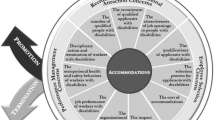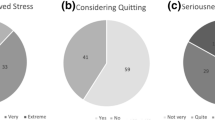Abstract
This research examines the role of police field training officers (FTOs) in the transfer of police academy training to the job. The authors issued a pilot survey instrument, the Police Learning Environment Inventory (PLEI), to assess the role of FTO behaviors in the transfer of academy training. The survey was issued to police organizations in the southwest and northeast regions of the USA. Survey responses were analyzed to determine both dimensional structure of FTO behaviors and their relationship to trainee intent to transfer academy training to the job. Results demonstrate that an array of FTO behaviors fall under a single dimension. Further, this behavioral dimension was significantly associated (p < .01) with police officer intent to transfer academy training to the field.
Similar content being viewed by others
References
Al-Eisa AS, Furayyan MA, Alhemound AM (2008) An empirical examination of the effects of self-efficacy, supervisor support and motivation to learn on transfer intention. Manag Decis 47(8):1221–1244. https://doi.org/10.1108/00251740910984514
Andridge RR, Little RJ (2010) A review of hot deck imputation for survey non-response. Int Stat Rev = Revue internationale de statistique 78(1):40–64
Baldwin TT, Ford JK (1988). Transfer of training: A review and directions for future research. Personnel Psychology 41(1): 63-105
Bennett D (2001) How can I deal with missing data in my study? Aust N Z J Public Health 25(5):464–469
Bergman ET, Roediger HL (1999) Can Bartlett’s repeated reproduction experiments be replicated? Mem Cogn 27(6):937–947
Brown TA (2015) Confirmatory factor analysis for applied research, 2nd edn. The Guilford Press, New York
Burke LA, Hutchins HM (2007) Training transfer: An integrative literature review. Hum Resour Dev Rev 6(3):263–296
Campbell J, Nadel L, Duke D, Ryan L (2011) Remembering all that and then some: Recollection of autobiographical memories after a one-year delay. Memory 19(4):406–415
Caro CA (2011) Predicting state police officer performance in the field training officer program: What can we learn from the cadet’s performance in the training academy? Am J Crim Justice 36:357–370
Chappell AT (2007) Community policing: Is field training the missing link? Policing: An International Journal of Police Strategies & Management 30(3):498–517
Chappell AT (2008) Police academy training: Comparing across curricula. Policing: An International Journal of Police Strategies & Management 31(1):36–56
Chiaburu DS, Van Dam K, Hutchins HM (2010) Social support in the workplace and training transfer: A longitudinal analysis. Int J Sel Assess 18(2):187–200. https://doi.org/10.1111/j.1468-2389.2010.00500.x
Costigan RD, Liter SS, Berman JJ (1998) A multi-dimensional study of trust in organizations. J Manag Issues 10(3):303–317
Costigan RD, Insinga RC, Berman JJ, Liter SS, Kranas G, Kureshov VA (2006) The effect of employee trust of the supervisor on enterprising behavior: A cross-cultural comparison. J Bus Psychol 21(2):273–291
Fischer MA (2018). Best practices guide for field training for today’s recruits. International Association of Chiefs of Police. https://www.theiacp.org/sites/default/files/2018-08/BP-FieldTrainingforTodaysRecruits.pdf. Accessed 22 Feb 2019
Ford JK, Quinones MA, Sego DJ, Sorra JS (1992) Factors affecting the opportunity to perform trained tasks on the job. Pers Psychol 45:511–527
Gaudine AP, Saks AM (2004) A longitudinal quasi-experiment on the effects of posttraining transfer interventions. Hum Resour Dev Q 15(1):57–76
Getty RM, Worrall JL, Morris RG (2016) How far from the tree does the apple fall? Field training officers, their trainees, and allegations of misconduct. Crime Delinq 62(6):821–839
Gist ME, Bavetta AG, Stevens CK (1990) Transfer training method – its influence on skill generalization, skill repetition, and performance level. Pers Psychol 43(3):501–523
Govaerts N, Dochy F (2014) Disentangling the role of the supervisor in transfer of training. Educ Res Rev 12:77–93
Grossman R, Salas E (2011) The transfer of training: What really matters. Int J Train Dev 15(2):103–120
Haarr RN (2001) The making of a community policing officer: The impact of basic training and occupational socialization on police recruits. Police Q 4(4):402–433
Haas NE, Van Craen M, Skogan WG, Fleitas DM (2015) Explaining officer compliance: The importance of procedural justice and trust inside a police organization. Criminol Crim Just 15(4):442–463
Harrison DA, McLaughlin ME (1993) Cognitive processes in self-report responses: Tests of item context effects in work attitude measures. J Appl Psychol 78:129–140
Hassan ZA, Schattner P, Mazza D (2006) Doing a pilot study: Why is it essential? Malays Fam Physician: the official journal of the Academy of Family Physicians of Malaysia 1(2-3):70–73
Hawley JD, Barnard JK (2005) Work environment characteristics and implications for training transfer: A case study of the nuclear power industry. Hum Resour Dev Int 8(1):65–80
Holgado-Tello FC, Chacón-Moscoso S, Barbero-García I, Vila-Abad E (2010) Polychoric versus Pearson correlations in exploratory and confirmatory factor analysis of ordinal variables. Qual Quant 44(1):153–166
Hopper M (1977) Becoming a policeman: Socialization of cadets in a police academy. Urban Life 6(2):149–170
Hu L, Bentler PM (2009) Cutoff criteria for fit indexes in covariance structure analysis: Conventional criteria versus new alternatives. Struct Equ Model Multidiscip J 6(1):1–55
Hunter-Johnson Y (2013) When training is not enough: An appeal to the work environment for transfer of training in the Bahamian Police Force. Int J Bahamian Stud 19:3–14
Hutchins HM, Nimon K, Bates R, Holton E (2013) Can the LTSI Predict Transfer Performance? Testing intent to transfer as a proximal transfer of training outcome. Int J Sel Assess 21(3):251–263
Kaminsky GF (2002). The field training concept in criminal justice agencies. Saddle River, New Jersey: Prentice-Hall.
Kindy K (2015). Creating guardians, calming warriors. Washington Post. http://www.washingtonpost.com/sf/investigative/2015/12/10/new-style-of-police-training-aims-to-produce-guardians-not-warriors/. Accessed 18 Oct 2017
Kline RB (2011) Principles and practice of structural equation modeling. Guilford press, New York
Lancaster S, Di Milia L, Cameron R (2013) Supervisor behaviours that facilitate training transfer. J Work Learn 25(1):6–22
Lee H (2004) The role of competence-based trust and organizational identification in continuous improvement. J Manag Psychol 19(6):623–639
Levin DZ, Cross R (2004) The Strength of Weak Ties You Can Trust: The Mediating Role of Trust in Effective Knowledge Transfer. Manag Sci 50(11):1477–1490
Lewis JD, Weigert A (1985) Trust as a social reality. Soc Forces 63:967–985
Liebermann S, Hoffman S (2008) The impact of practical relevance on training transfer: evidence from a service quality training program for German bank clerks. Int J Train Dev 12(2):74–86. https://doi.org/10.1111/j.1468-2419.2008.00296.x
Lim DH, Morris ML (2006) Influence of trainee characteristics, instructional satisfaction, and organizational climate on perceived learning and training transfer. Hum Resour Dev Q 17(1):85–115
Martin HJ (2010) Improving training impact through effective follow-up: Techniques and their application. J Manag Dev 29(6):520–534
Martin HJ (2010b) Workplace climate and peer support as determinants of training transfer. Hum Resour Dev Q 21(1):87–104. https://doi.org/10.1002/hrdq.20038
Martocchio JJ (1992) Microcomputer usage as an opportunity – the influence of context in employee training. Pers Psychol 45(3):529–552
Massoni M (2009) Field Training Programs. FBI Law Enforcement Bull 78(2):1–5. https://ezproxy.mclennan.edu/login?url=http://search.ebscohost.com/login.aspx?direct=true&db=voh&AN=37562593&site=eds-live. Accessed 13 Sept 2017
Mastrofski SD, Ritti RR (1996) Police training and the effects of organizations on drunk driving enforcement. Justice Q 13(2):291–320
May GL, Kahnweiler WM (2000) The effect of a mastery practice design on learning and transfer in behavior modeling training. Pers Psychol 53(2):353–373
McAllister DJ (1995) Affect-and cognition-based trust as foundations for interpersonal cooperation in organizations. Acad Manag J 38(1):24–59
McCampbell MS (1987) Field training for police officers: The state of the art. National Institute of Justice, Washington
McFadden D (1977) Quantitative methods for analyzing travel behaviour of individuals: Some recent developments. In: Cowles Foundation Discussion Papers 474, Cowles Foundation for Research in Economics. University, Yale
Möllering G (2001) The Nature of Trust: From Georg Simmel to a Theory of Expectation, Interpretation and Suspension. Sociology 35(2):403–420
Nix J, Pickett JT, Baek H, Alpert GP (2017) Police research, officer surveys, and response rates. Polic Soc. https://doi.org/10.1080/10439463.2017.1394300
Nunnally JC, Bernstein IH (1994) Psychometric Theory, 3rd edn. McGraw-Hill, New York
Olson K (2010) An Examination of Questionnaire Evaluation by Expert Reviewers. Field Methods 22(4):295–318
Quinones M (1995) Pretraining context effects: Training assignment as feedback. J Appl Psychol 80:226–238
Robbins SP, Judge TA (2009) Organizational Behavior. Pearson Prentice Hall, Upper Saddle River
Rosseel Y (2012) lavaan: An R Package for Structural Equation Modeling. J Stat Softw 48(2):1–36
Saks AM, Burke LA (2012) An investigation into the relationship between training evaluation and the transfer of training. Int J Train Dev 16(2):118–127
Simosi M (2012) The moderating role of self-efficacy in the organizational culture–training transfer relationship. Int J Train Dev 16(2):92–106
Singleton R, Straits BC (2005) Approaches to social research. Oxford University Press, Oxford
Smith EM, Ford JK, Kozlowski SWJ (1997) Building adaptive expertise: Implications for training design strategies. In M. A. Quinones and A. Ehrenstein (Eds.), Training for a rapidly changing workplace: Applications of psychological research (pp. 89–118). Washington, D.C.: American Psychological Association.
Sookhai F, Budworth M (2010) The trainee in context: Examining the relationship between self-efficacy and transfer climate for transfer of training. Hum Resour Dev Q 21(3):257–272. https://doi.org/10.1002/hrdq.20044
Steiner B, Schwartz J (2006) The scholarly productivity of institutions and their faculty in leading criminology and criminal justice journals. J Crim Just 34(4):393–400
Stogdill RM (1974) Handbook of leadership: A survey of theory and research. Free Press, New York
Sun IY (2002) Police officer attitudes toward peers, supervisors, and citizens: A comparison between field training officers and regular officers. Am J Crim Justice 27(1):69–83
Willis GB (2005) Cognitive interviewing: A tool for improving questionnaire design. Sage Publications, Thousand Oaks
York T, Whitford A, Williams BN (2012) Command & Control meets the Millennials. Am Jails 26(2):23–31 https://ezproxy.mclennan.edu/login?url=http://search.ebscohost.com/login.aspx?direct=true&db=a9h&AN=77491303&site=ehost-live. Accessed 13 Sept 2017
Yukl GA (2002) Leadership in organizations. Prentice Hall, Upper Saddle River
Author information
Authors and Affiliations
Corresponding author
Ethics declarations
Conflict of Interest
The authors declare that they have no conflicts of interest.
Ethical Approval
All procedures performed in studies involving human participants were in accordance with the ethical standards of the McLennan Community College Institutional review Board and with the 1964 Helsinki declaration and its later amendments or comparable ethical standards.
Informed Consent
Informed consent was obtained from all individual participants included in the study.
Additional information
Publisher’s Note
Springer Nature remains neutral with regard to jurisdictional claims in published maps and institutional affiliations.
The views expressed in this article are those of the author, and do not necessarily reflect those of the U.S. Department of State or the U.S. Government.
Rights and permissions
About this article
Cite this article
Dulin, A., Dulin, L. & Patino, J. Transferring Police Academy Training to the Street: the Field Training Experience. J Police Crim Psych 35, 432–442 (2020). https://doi.org/10.1007/s11896-019-09353-2
Published:
Issue Date:
DOI: https://doi.org/10.1007/s11896-019-09353-2




